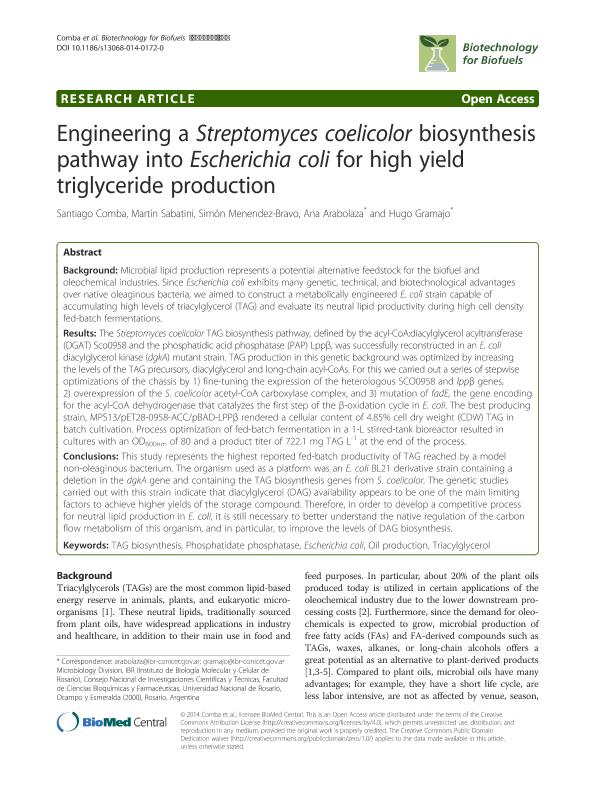Mostrar el registro sencillo del ítem
dc.contributor.author
Comba, Santiago

dc.contributor.author
Sabatini, Martín

dc.contributor.author
Menendez-bravo, Simón Matías

dc.contributor.author
Arabolaza, Ana Lorena

dc.contributor.author
Gramajo, Hugo Cesar

dc.date.available
2017-12-04T19:34:22Z
dc.date.issued
2014-09
dc.identifier.citation
Comba, Santiago; Sabatini, Martín; Menendez-bravo, Simón Matías; Arabolaza, Ana Lorena; Gramajo, Hugo Cesar; Engineering a Streptomyces coelicolor biosynthesis pathway into Escherichia coli for high yield triglyceride production; BioMed Central; Biotechnology For Biofuels; 7; 9-2014; 172-183
dc.identifier.issn
1754-6834
dc.identifier.uri
http://hdl.handle.net/11336/29606
dc.description.abstract
Background Microbial lipid production represents a potential alternative feedstock for the biofuel and oleochemical industries. Since Escherichia coli exhibits many genetic, technical, and biotechnological advantages over native oleaginous bacteria, we aimed to construct a metabolically engineered E. coli strain capable of accumulating high levels of triacylglycerol (TAG) and evaluate its neutral lipid productivity during high cell density fed-batch fermentations. Results The Streptomyces coelicolor TAG biosynthesis pathway, defined by the acyl-CoA:diacylglycerol acyltransferase (DGAT) Sco0958 and the phosphatidic acid phosphatase (PAP) Lppβ, was successfully reconstructed in an E. coli diacylglycerol kinase (dgkA) mutant strain. TAG production in this genetic background was optimized by increasing the levels of the TAG precursors, diacylglycerol and long-chain acyl-CoAs. For this we carried out a series of stepwise optimizations of the chassis by 1) fine-tuning the expression of the heterologous SCO0958 and lpp β genes, 2) overexpression of the S. coelicolor acetyl-CoA carboxylase complex, and 3) mutation of fadE, the gene encoding for the acyl-CoA dehydrogenase that catalyzes the first step of the β-oxidation cycle in E. coli. The best producing strain, MPS13/pET28-0958-ACC/pBAD-LPPβ rendered a cellular content of 4.85% cell dry weight (CDW) TAG in batch cultivation. Process optimization of fed-batch fermentation in a 1-L stirred-tank bioreactor resulted in cultures with an OD600nm of 80 and a product titer of 722.1 mg TAG L-1 at the end of the process. Conclusions This study represents the highest reported fed-batch productivity of TAG reached by a model non-oleaginous bacterium. The organism used as a platform was an E. coli BL21 derivative strain containing a deletion in the dgkA gene and containing the TAG biosynthesis genes from S. coelicolor. The genetic studies carried out with this strain indicate that diacylglycerol (DAG) availability appears to be one of the main limiting factors to achieve higher yields of the storage compound. Therefore, in order to develop a competitive process for neutral lipid production in E. coli, it is still necessary to better understand the native regulation of the carbon flow metabolism of this organism, and in particular, to improve the levels of DAG biosynthesis
dc.format
application/pdf
dc.language.iso
eng
dc.publisher
BioMed Central

dc.rights
info:eu-repo/semantics/openAccess
dc.rights.uri
https://creativecommons.org/licenses/by-nc-sa/2.5/ar/
dc.subject
Escherichia Coli
dc.subject
Oil Production
dc.subject
Phosphatidate Phosphatase
dc.subject
Tag Biosynthesis
dc.subject
Triacylglycerol
dc.subject.classification
Otras Ciencias Biológicas

dc.subject.classification
Ciencias Biológicas

dc.subject.classification
CIENCIAS NATURALES Y EXACTAS

dc.title
Engineering a Streptomyces coelicolor biosynthesis pathway into Escherichia coli for high yield triglyceride production
dc.type
info:eu-repo/semantics/article
dc.type
info:ar-repo/semantics/artículo
dc.type
info:eu-repo/semantics/publishedVersion
dc.date.updated
2017-12-04T19:15:47Z
dc.journal.volume
7
dc.journal.pagination
172-183
dc.journal.pais
Reino Unido

dc.journal.ciudad
Londres
dc.description.fil
Fil: Comba, Santiago. Consejo Nacional de Investigaciones Científicas y Técnicas. Centro Científico Tecnológico Conicet - Rosario. Instituto de Biología Molecular y Celular de Rosario. Universidad Nacional de Rosario. Facultad de Ciencias Bioquímicas y Farmacéuticas. Instituto de Biología Molecular y Celular de Rosario; Argentina
dc.description.fil
Fil: Sabatini, Martín. Consejo Nacional de Investigaciones Científicas y Técnicas. Centro Científico Tecnológico Conicet - Rosario. Instituto de Biología Molecular y Celular de Rosario. Universidad Nacional de Rosario. Facultad de Ciencias Bioquímicas y Farmacéuticas. Instituto de Biología Molecular y Celular de Rosario; Argentina
dc.description.fil
Fil: Menendez-bravo, Simón Matías. Consejo Nacional de Investigaciones Científicas y Técnicas. Centro Científico Tecnológico Conicet - Rosario. Instituto de Biología Molecular y Celular de Rosario. Universidad Nacional de Rosario. Facultad de Ciencias Bioquímicas y Farmacéuticas. Instituto de Biología Molecular y Celular de Rosario; Argentina
dc.description.fil
Fil: Arabolaza, Ana Lorena. Consejo Nacional de Investigaciones Científicas y Técnicas. Centro Científico Tecnológico Conicet - Rosario. Instituto de Biología Molecular y Celular de Rosario. Universidad Nacional de Rosario. Facultad de Ciencias Bioquímicas y Farmacéuticas. Instituto de Biología Molecular y Celular de Rosario; Argentina
dc.description.fil
Fil: Gramajo, Hugo Cesar. Consejo Nacional de Investigaciones Científicas y Técnicas. Centro Científico Tecnológico Conicet - Rosario. Instituto de Biología Molecular y Celular de Rosario. Universidad Nacional de Rosario. Facultad de Ciencias Bioquímicas y Farmacéuticas. Instituto de Biología Molecular y Celular de Rosario; Argentina
dc.journal.title
Biotechnology For Biofuels

dc.relation.alternativeid
info:eu-repo/semantics/altIdentifier/url/https://biotechnologyforbiofuels.biomedcentral.com/articles/10.1186/s13068-014-0172-0
dc.relation.alternativeid
info:eu-repo/semantics/altIdentifier/doi/http://dx.doi.org/10.1186/s13068-014-0172-0
Archivos asociados
